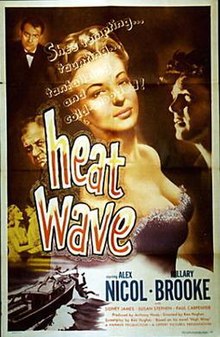

| The House Across the Lake | |
|---|---|

American release poster
| |
| Directed by | Ken Hughes |
| Written by | Ken Hughes |
| Based on | High Wray by Ken Hughes |
| Produced by | Anthony Hinds |
| Starring | Alex Nicol Hillary Brooke Susan Stephen |
| Cinematography | Walter J. Harvey |
| Edited by | James Needs |
| Music by | Ivor Slaney |
Production | |
| Distributed by | Exclusive Films Lippert Pictures (US) |
Release date |
|
Running time | 68 minutes |
| Country | United Kingdom |
| Language | English |
The House Across the Lake (U.S. title: Heat Wave) is a 1954 British film noir crime film directed by Ken Hughes and starring Alex Nicol, Hillary Brooke, Sid James and Susan Stephen.[1] It was produced as a second feature[2]byHammer Films. It was released in the United States by Lippert Pictures .
An American pulp novelist, Mark Kendrick, meets his rich neighbours across the lake and is soon seduced by beautiful blonde Carol, the wife of Beverly Forrest, despite Beverly treating him as a friend. When Beverly is badly injured by a fall on his boat, Carol fails to persuade Mark to throw him overboard, so Carol does it.
After first refusing to go along with her plan to call it an accident, Mark agrees when Carol tells him that they will meet up again later and live off her dead husband's money. However, after the coroner rules the death an accident, Mark does not hear from her, but the still suspicious CID inspector on the case arranges for Mark to find out that Carol has secretly married another old flame and changed residences. Mark angrily confronts her, but she sneers that she only used him and that there is nothing he can do about it without implicating himself. Mark decides to confess, thinking that, although it will probably mean a prison sentence for him, it will mean the rope for Carol.
The film was based on the 1952 novel High Wray by Ken Hughes.[3] It was filmed at Bray Studios.[4] Nicol and Brooke were the only Americans in the cast, although Brooke played a British character. Her mastery of a "posh" accent caused her to be typecast as British in Hollywood films starting in the 1940s.[5][6]
The Monthly Film Bulletin wrote: "Yet another vehicle for American stars, with British players in support. Alex Nicol plays adequately as Kendrick, Alan Wheatley gives a neat, incisive performance as the inspector, and the film is well constructed and photographed. Unfortunately, the plot revolves around the fatal charm of Carol Forrest, and Hillary Brooke cannot make this seem credible."[7]
According to The Independent, "The film was praised by critics, and began Hughes's ascent into more important productions."[8]
Filmink said "It’s quite a fun movie, reminiscent of The Postman Always Rings Twice (1946); one is inclined to wonder if Nicol’s character, a writer under the pump and distracted by lust, was a Hughes self-portrait."[9]
|
Films directed by Ken Hughes
| |
|---|---|
| Features |
|
| Shorts |
|